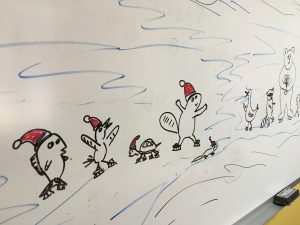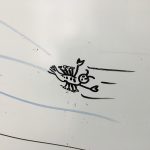 We have a very large whiteboard in the conference room at HRWC, and the holidays prompted some doodling across its vast expanse. Suddenly, the Huron River was populated with all sorts of creatures having some winter fun, skating away…you know, like they do.
We have a very large whiteboard in the conference room at HRWC, and the holidays prompted some doodling across its vast expanse. Suddenly, the Huron River was populated with all sorts of creatures having some winter fun, skating away…you know, like they do.
The scientists loved it – mostly. Just a few quibbles, really, and what struck me was that the concerns were NOT that the scene included Santa and his reindeer, a snowman, and that all the watershed animals were on skates. Oh, no. That was all fine! The two issues were:
- the crayfish was skating forward and not backward as nature intended
- there was a bear in the scene, and there are no bears in the watershed
The ensuing conversation, while amusing (the 2011 black bear sighting at Hudson Mills was submitted, and rejected, as evidence as it seems he/she was “just passing through”), showed the depth and breadth of scientific inquiry that is the norm at HRWC. We take a good hard look at everything, and that is to the advantage of the river, the watershed and all the creatures in it.
You just can’t get away with fake news at HRWC. A skating bear on the Huron is going to get fact-checked in all directions. A crayfish with forward momentum is simply not right, and all the

scientists on staff are going to let you know this (nicely, of course!), and then you are going to get to examine the crayfish poster (yes, we have a crayfish poster!) for information, and the conversation spirals off into what are common to the watershed (virile, northern clearwater and others) and can you eat them like crawdads (yes) and what kind of crayfish are crawdads anyway (red swamp crayfish – invasive to Michigan).
And when you have that level of examination over a cartoon crayfish, you can imagine what happens here on the more serious issues. Impacts of 1,4 dioxane on aquatic life? We are searching globally for the latest science. PAH content of “synthetic” coal tar sealants? We’re on it.
Because that’s how we do things here.
To learn more about the science behind our work, please join us on Thurs, Jan 19, 6-8pm for our Volunteer Appreciation and Season Results Presentation. Through the lens of the Huron’s many creeksheds, HRWC staff will share stories and lessons learned from our 2016 field season at this fun annual event. We will feature 2016 highlights and 2017 plans from our Bioreserve, Fish Habitat, River Bug Studies, and Water Quality programs. NEW Center, 2nd Floor, 1100 North Main Street, Ann Arbor. Register by email: jfrenzel@hrwc.org.
–Rebecca Foster, Development Associate



